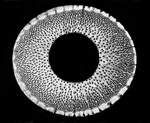|
1950, and on ... : The Origin of 'Suizen' at Kyōto Myōan-ji:
Kobayashi Shizan, Tomimori Kyozan,
Tanikita Muchiku, Yasuda Tenzan,
Hirazumi Taizan, Koizumi Ryōan,
Fukumoto Kyoan, Yoshimura Sōshin a.o.
「吹禅」 - SUIZEN ... "Blowing Zen", really?
"Blowing a Flute Self-cultivation" - "Flute-blown Mental Training" ... ?
Or: "Blowing a Flute Non-dualistic Contemplative Practice"?
"Ascetic Bamboo Flute Practice" - "Non-Dualistic Shakuhachi Asceticism" ...
This is a research and critical online information web page project in continuous progress.
Last updated on February 11, 2025.
From "ASCETIC BREATHING" to 'SUIZEN' - a DOCUMENTED TIMELINE
TIMELINE - BACKGROUND
気息修行 - KISOKU SHUGYŌ
1823: The Edo, Kinko-line shakuhachi affiliated player Hisamatsu Fūyō explains his shakuhachi practice
as 'Kisoku shugyō',
気息修行,
"Breathing Asceticism", or "Ascetic Breath Practice".
In fact, it still remains quite unclear whether Hisamatsu Fūyō was ever a 'Komusō', himself.
And, besides, Hisamatsu made it clear that he was indeed not "a Zen monk".
Source: Hitori mondō, 1823, c/o Kishi Kiyokazu.
Links: http://www.dental.gr.jp/bmbnt/bamboo199.htm
http://komuso.ch/wp-content/uploads/2010/09/Hitori_Mondou_e.pdf
吹笛修行 - SUITEKI SHUGYŌ
1852: The 32nd Kyōto Myōan-ji 'Kansu',
看首,
"supervisor", "director", Rodō Genkyō,
coins and presents the novel term 'Sui-teki shugyō',
吹笛修行,
"Blowing a Flute Ascetic Activity".
That was, in fact, especially with regard to begging activities in which
only a maximum of two participants were allowed to travel and beg for alms together,
Rodō Genkyō stated in his decree.
Source: Nakatsuka Chikuzen, 1979, p. 176.
Visit this web page for more information - will open in a new browser window:
1852: Kyōto Myōan-ji's 32nd 'Kansu' Rodō Genkyō's
Commandments Regarding 'Komusō' Begging Practice
and 'Sui-teki shugyō' - and the Possible Origin
of the Now so Very Misused Term 'Suizen'?
吹笛修行留 - SUITEKI SHUGYŌ-TOME
1857, first month: The 'Komusō' temple Fudai-ji issues a partly pre-printed 'Suiteki shugyō-tome',
吹笛修行留,
"Authorized Place for Flute-playing Ascetic Practice" "Fuke Shūmon Supervision Certificat".
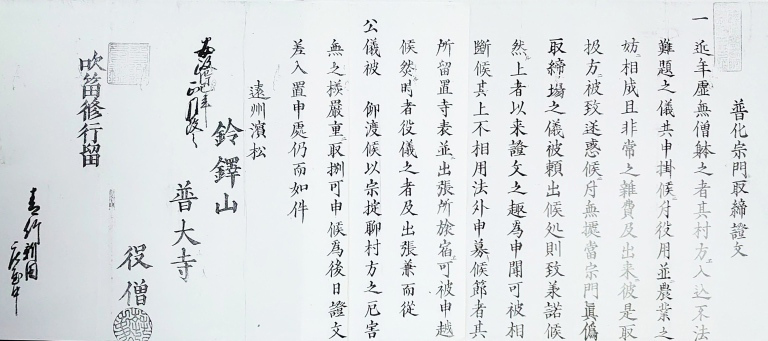
This document is awaiting further investigation and possible interpretation ☺
Source: Kunimi Masafumi's shakuhachi website -
Link: https://kisokuseikan.at.webry.info/202011/article_4.html
1858: Reihō-ji Document about 'Takuhatsu Suiteki'
and 'Takuhatsu Suiteki Shugyō'
- Neither 'Suishōzen' Nor 'Suizen' ...
Again: No 'Shakuhachi Meditation" Confirmation there!
托鉢吹笛 - 托鉢吹笛修行
'TAKUHATSU SUITEKI SHUGYŌ'
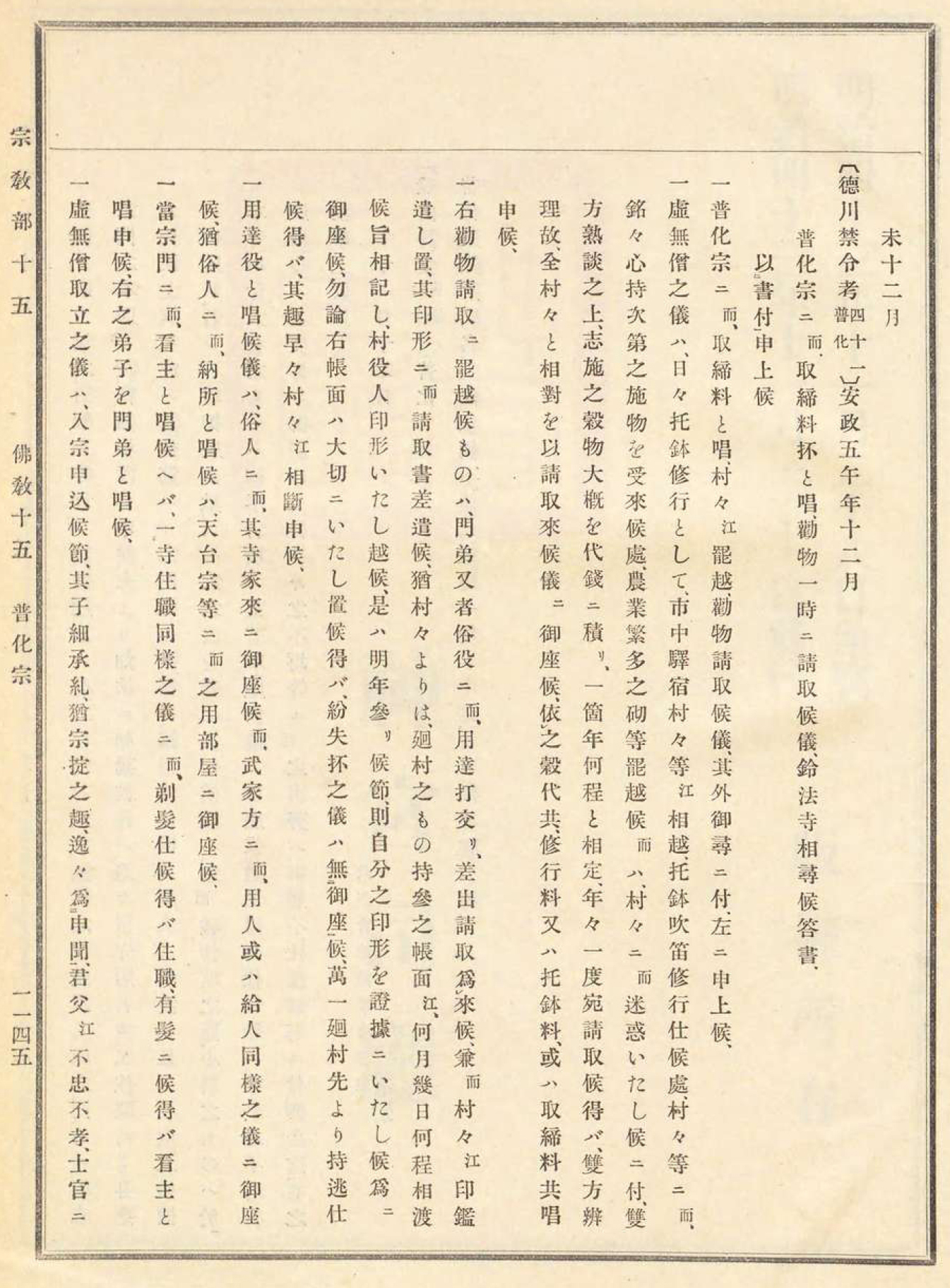
Pages scanned from Koji Ruien, Section of Religion: 'Fuke-shū', pp. 1145-1146.
NB!: Not a single word about "Shakuhachi meditation", nor 'Suizen', in that 1858 document, either - even only two decades before
the final fall of the Tokugawa régime!
1914, November 22: the 35th Myōan 'Kansu', Higuchi Taizan, founder of the 'Myōan Taizan-ha' ascetic shakuhachi tradition, dies.
Kobayashi Kyozan is appointed 36th 'Kansu'.
Source: http://myouan-doushukai.org/generation.html
1928, first printed and published in 1936: Uramoto Setchō authors three essays on the topic of 'Fuke Shakuhachi',
but he does not mention the term 'Suizen' anywhere, there.
Source: The National Diet Library, Tokyo.
Link: https://dl.ndl.go.jp/info:ndljp/pid/1222923
- go to book pages 195 through 242/pdf page frames 107 through 131
吹簫禅 - SUI-SHŌ-ZEN
1928, March 15: 'Kyozan-bō',
虚山坊, most probably "Young Kyozan", alias Tomimori Kyozan,
authors an article on pages 23-25 in the Myōan Kyōkai bulletin Dai Myōan,
大明暗,
titled 'Sui-shō-zen man-go',
吹簫禅 漫語,
"This and That regarding (the Term) 'Blowing a Flute Meditation'".
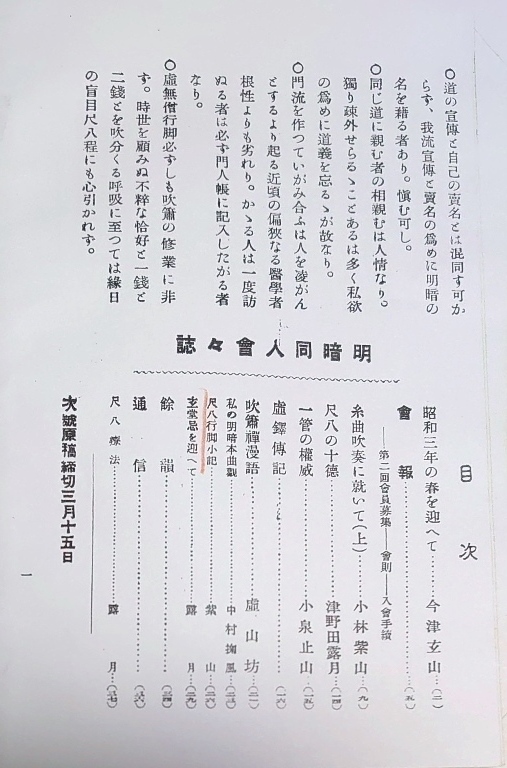
Source: Kunimi Masafumi's website.
Link: https://kisokuseikan.at.webry.info/202004/article_2.html
尺八本流明暗吹簫法基階
'Shakuhachi honryū Myōan suishō-hō kikai'
"The Fundamental Principles of Playing the Shakuhachi of the True Myōan Tradition"
1930: Kobayashi Shizan & Tomimori Kyozan co-write a 232+4 pages book in three parts on 'Myōan Shakuhachi',
in which the very first 13-page chapter is an introduction to the origin of that very new "idea" and term,
'Sui-shō-zen', 吹簫禅,
"Blowing a Flute Zen Meditation" - "Blowing a Shakuhachi Ascetic Practice".
Title of chapter 1:
'Sui-shō-zen', 明暗吹簫禪の來由,
'Myōan suishō-zen no raitai',
"The Cause and Origin of the Myōan Blowing a Flute Zen Self-cultivation".
Chapter 4, 29 pages, deals with "The Revival of the Myōan Way of Playing",
明暗吹簫道の復古,
'Myōan suishō-dō no fukko'.
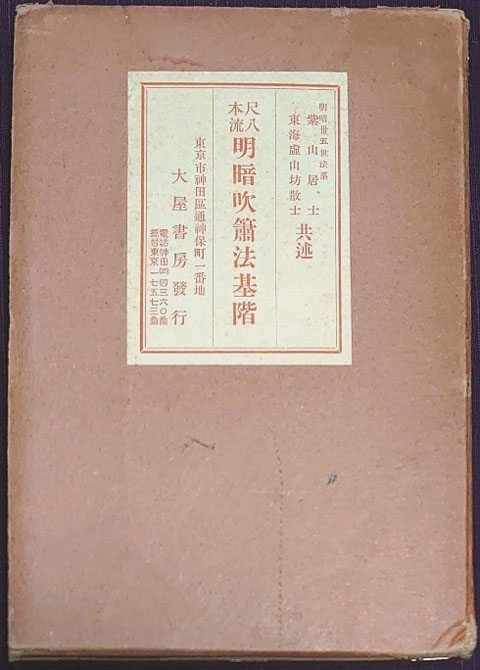
Kobayashi and Tomimori's 1930 'Myōan suishō-hō' book cover, front.
Picture source: Kunimi Masafumi's Kisokuseikan website, see link below.
Sources: Kisokuseikan & The National Diet Library, Tokyo.
Links: https://kisokuseikan.seesaa.net/article/202004article_2.html
& https://dl.ndl.go.jp/info:ndljp/pid/1258947?itemId=info%3Andljp%2Fpid%2F1258947&__lang=en
Study the complete list of contents on this local web page:
https://zen-shakuhachi.dk/to1930suishouzenbook.htm
1938, November 27: The 36th Myōan 'Kansu', Kobayashi Kyozan, dies.
The position as 'Kansu' is left vacant for around 10 years, most probably because of the impacts of World War II.
Source: http://myouan-doushukai.org/generation.html
1949: Tanikita Muchiku is appointed 37th 'Kansu'.
1950-1953: Yasuda Tenzan,
安田天山,
serves as the first, and founding, chief monk, "abbot"?,
再興明暗寺 初代住職,
'Saikō Myōan-ji Shodai jū-shoku',
of the new, revived Kyōto Myōan-ji.
Yasuda-san produces at least a few quite impressive 'Suizen' calligraphies - see below.
1950s:
By the early 1950s, it appears that at least these eight prominent Myōan-ji personalities would have been engaged - directly or indirectly - in the creation,
promotion and consolidation of the new Taizan-ha Ascetic Shakuhachi term 'Suizen':
Kobayashi Shizan, Tomimori Kyozan, Tanikita Muchiku, Yasuda Tenzan,
Hirazumi Taizan, Koizumi Ryōan, Fukumoto Kyoan & Yoshimura Sōshin.
Besides, these personalities could also have contributed, one way or another:
Minamoto Unkai, Miyagawa Nyozan, Uramoto Setchō, Ikeda Jūzan,
Okamoto Chikugai, and Matsumoto Kyozan.
1953: Tanikita Muchiku leaves the office of 'Kansu' and is succeeded by Koizumi Ryōan as 38th 'Kansu'.
Sources: http://myouan-doushukai.org/generation.html
https://www.komuso.com/people/index.pl
1953: Hirazumi Taizan is appointed 2nd head monk of Myōan-ji; - years later, he produces one very impressive 'Mu-ku-teki Suizen' calligraphy - see image at page down.
Source: http://myouan-doushukai.org/generation.html
1955, July: The 37th Myōan-ji 'Kansu' Tanikita Muchiku publishes an article in the Myōan-ji bulletin 'Suizen', Issue No. 2.
Kunimi Masafumi's shakuhachi website.
Link: https://kisokuseikan.seesaa.net/article/202004article_2.html
1953-56:
Most probably during the early 1950s, Tanikita Muchiku, birth name: Kensaburō, supervised the recording
and production of 'Taizan-ryū Shakuhachi' pieces for the new 33 r.p.m. vinyl record sound format,
the "LP": the "long-playing record".
12 record discs in all, Tanikita Sensei recorded the majority of the pieces, himself, but a number of other players are represented, as well.
Obviously, the term 'Suizen' was not chosen to be part of this collection's official title:
対山流尺八 Ⅰ~ⅩⅡ
吹奏 谷北兼三郎
"Taizan-ryū Shakuhachi I~XII
Performance: Tanikita Kensaburō" (and others)
The LP set was produced privately, for non-commercial purposes - see link to towa33.com below.
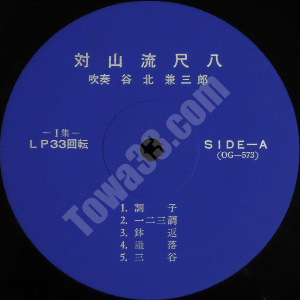
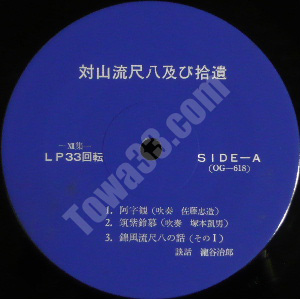
'Taizan-ryū Shakuhachi' LP labels I & XII
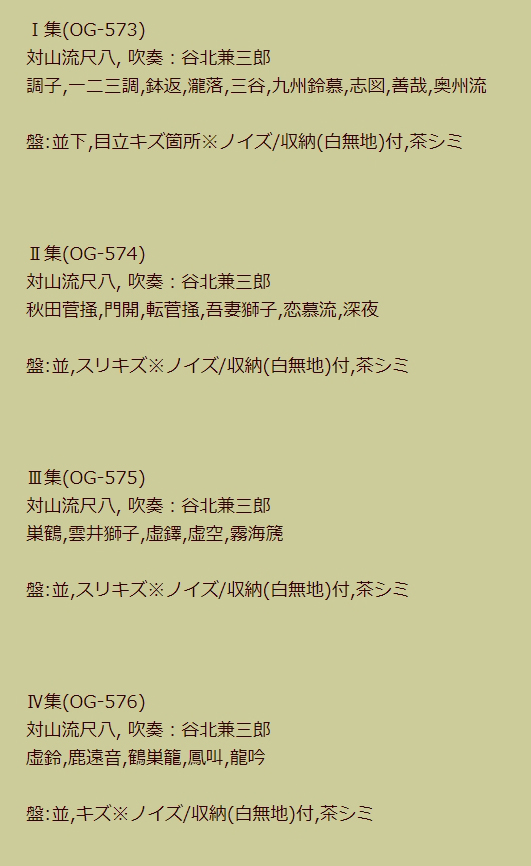
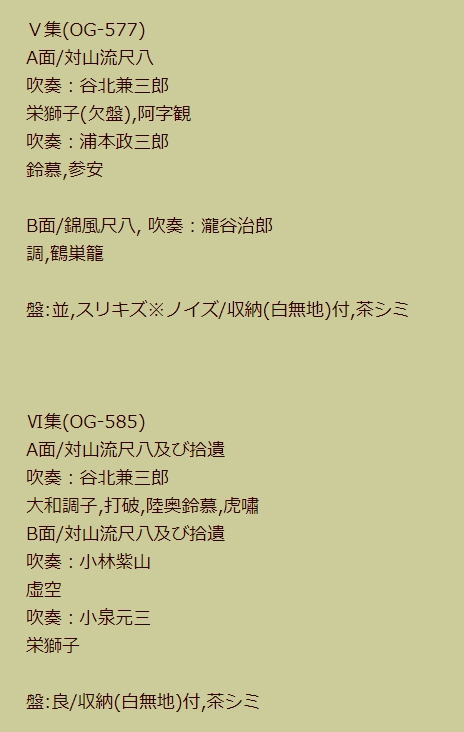
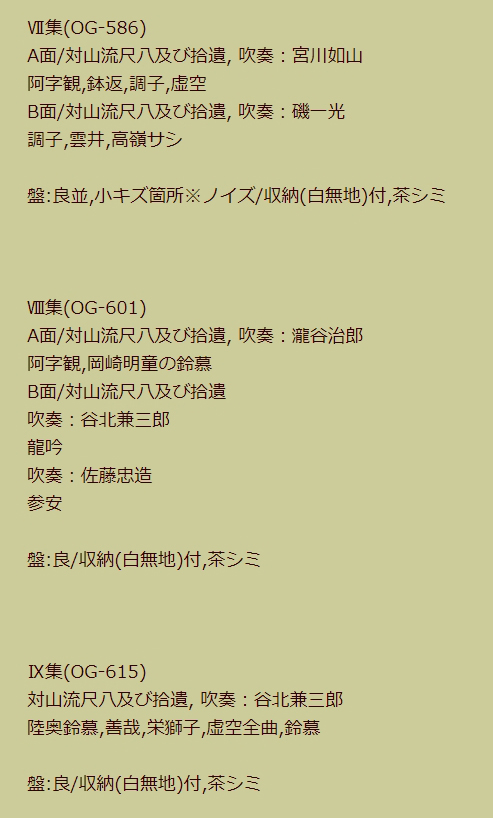
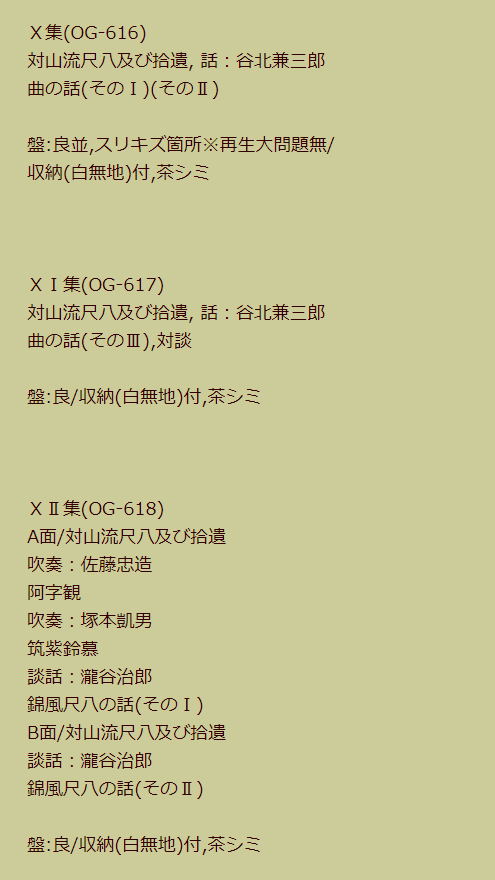
Tanikita Muchiku 12 LP record set, tracklist LPs 1-12 - towa33.com description
Source: TOWADŌ - http://towa33.com/?page=70&cid=14
Another preserved Tanikita Muchiku honkyoku collection not titled 'Suizen' was given the name
'Tanikita Muchiku no Shakuhachi - Tanikita hito-goe hen',
谷北無竹の尺八 - 谷北一声編,
"Tanikita Muchiku's Shakuhachi - The Tanikita Single Voice Collection" - see link to towa33.com below.
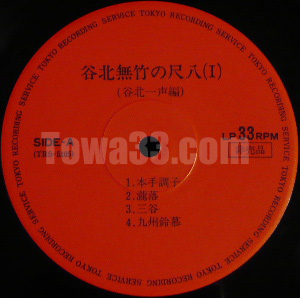
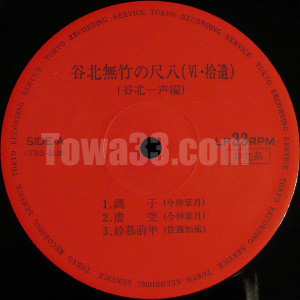
'Tanikita Muchiku no Shakuhachi' LP labels I & VI
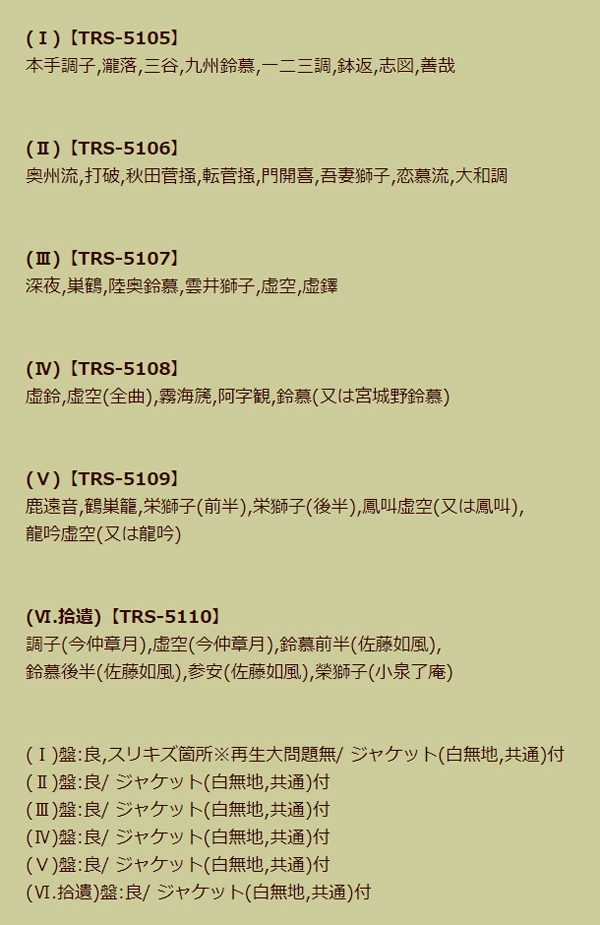
Tanikita Kensaburō TRS 5105-5110 tracklist - towa33.com description
Source: TOWADŌ - http://towa33.com/?eid=5664
With the appearance in Japan of the music cassette tape in the early 1960s, selected Tanikita Muchiku
recordings were also prepared for that new format and released in a triple-MC set titled
'Shakuhachi honkyoku no genryū o motomete, Tanikita Muchiku-shū I-III',
尺八本曲の源流を求めて
明暗三十七世谷北無竹Ⅰ~Ⅲ
'Shakuhachi honkyoku no genryū o motomete
Myōan sanjūnana-sei Tanikita Muchiku-shū'
"In Search of the Fountainhead of Shakuhachi Honkyoku
The 37th ['Kansu'] Tanikita Muchiku Anthology I-III"
The first published set of music cassettes was designed like this - seen at aucfree.com:
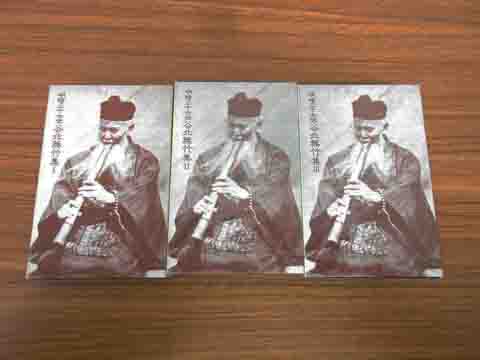
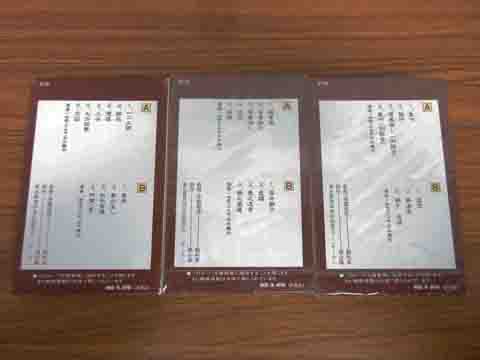
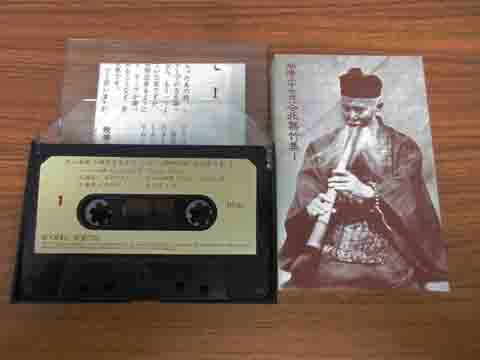
Here is a link to a complete track list at komuso.com:
https://www.komuso.com/people/people.pl?person=469
A following version of the set had these three front cover portraits:
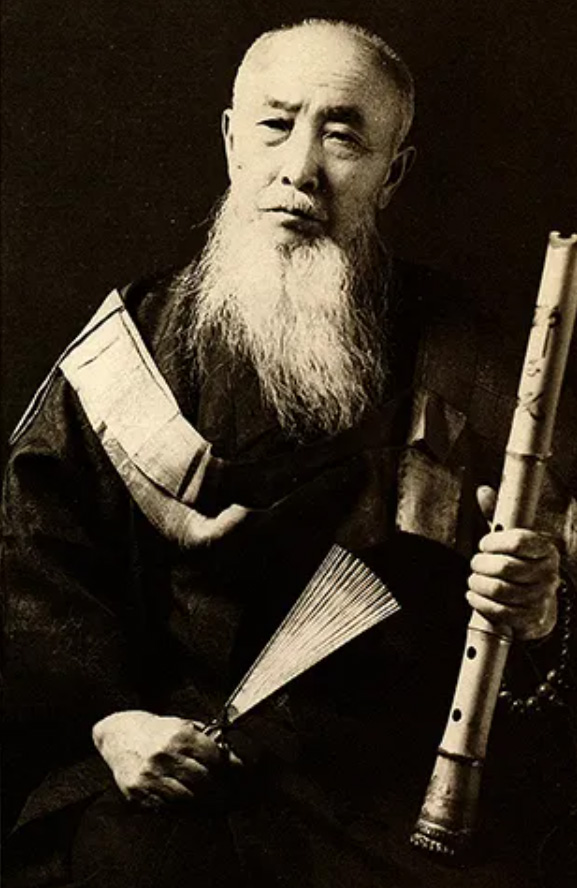
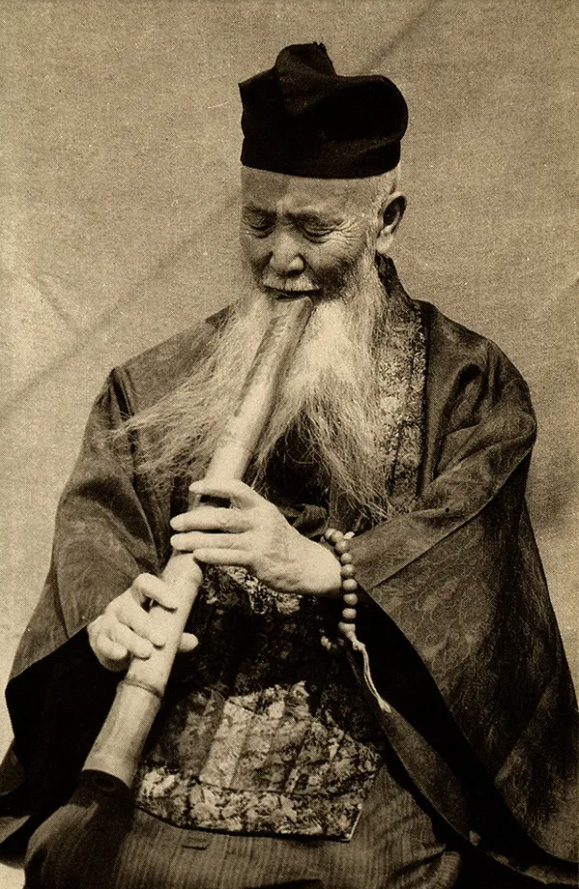
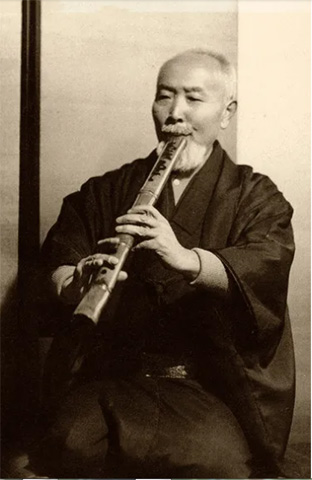
Two of the three inlay cards were designed like this:
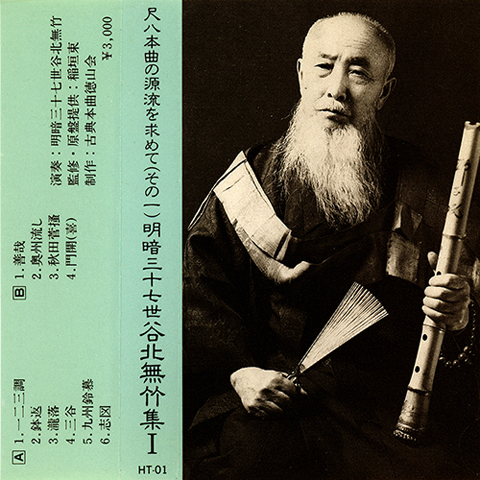
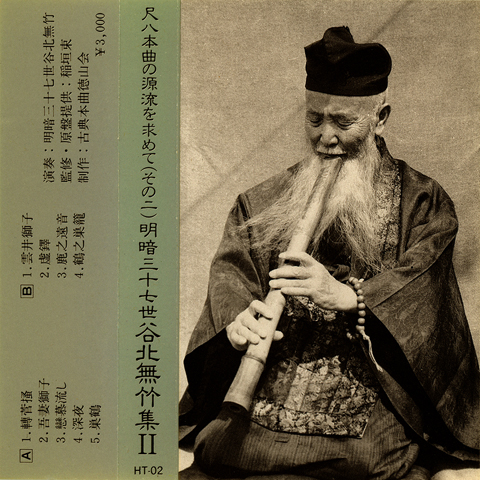
Obviously, none of these Taizan-ryū/Tanikita Muchiku releases were marketed under the title, or headline, 'Suizen'
- and none of them carry any precise release date, unfortunately so ...
However, acc. to Christian T. Mau, the recordings for the music cassette set were made by Tanikita's student
Inagaki Ihaku during the period 1953-1956.
Phonogram/MC numbers: HT01, HT02, & HT03.
Source: Christian T. Mau thesis, 2014, pages 183 and 230.
Link: http://eprints.soas.ac.uk/18260
The Sugiyama Jogakuen University Digital Library presents
Historical Recordings Featuring Legendary Seien-ryū
and Taizan-ryū/Taizan-ha Shakuhachi Players:
Link to numerous historical shakuhachi recordings,
including those on the above Tanikita Muchiku LP collections:
https://zeami.ci.sugiyama-u.ac.jp/~izuka/erito1/iwata1.html
1956:
A dated photo of Iwata Seien with shakuhachi friends and noble wives - and a fine recording of 'Ajikan' of his:
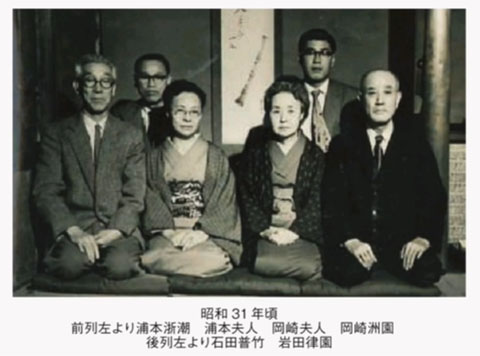
Link to YouTube: 'Ajikan' played by Iwata Seien - no date.
Persons in the picture - In the back from the left:
Ishida Fuchiku,
石田普竹,
and Iwata Seien,
岩田律園.
Below from the left:
Uramoto Setchō and Mrs. Uramoto,
浦本浙潮,
and Mrs. Okazaki and Mr. Okazaki Shūen,
岡崎洲園, himself.
1957, March 24: Tanikita Muchiku dies.
Source: http://myouan-doushukai.org/generation.html
1960: Parallelly, Uramoto Setchō introduces the explanatory term 'Gyō no ongaku',
行の音楽,
"Ascetic Music" - however without referring specifically to 'Suizen' in that article of his.
Read more here:
1960: Uramoto Setchō's Statement about
'Gyō no ongaku': "Ascetic Music"
1966: A now very popular 'Suizen' stone monument is erected to the left inside of the gate of Kyōto Myōan-ji.
Sources:
http://myoanshakuhachi.blogspot.com/2012/06/those-who-wanted-to-emphasize-suizen.html
http://myoanshakuhachi.blogspot.com/2012/06/
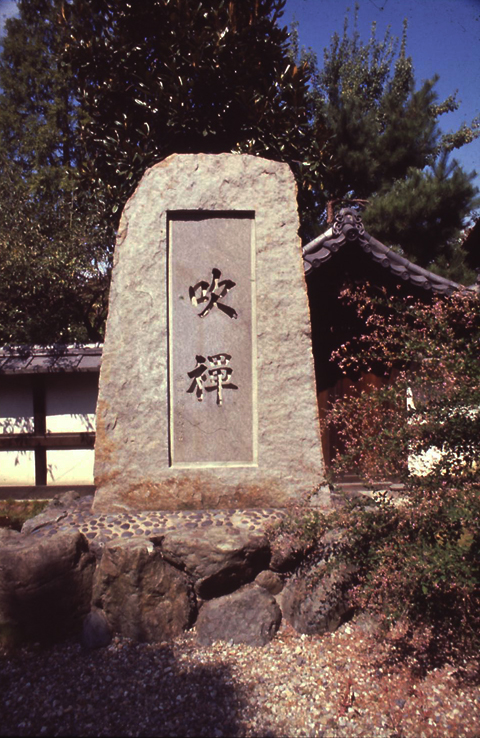
Photo by Torsten Olafsson, early Spring, 1977.
1968, October 27: Tomimori Kyozan is interviewed by Rekisen Yokō [?],
礫川餘光,
Source: http://shakuhachistuff.blogspot.com/2009/12/s-interview-with-tomimori-kyozan-1.html
On Saturday August 8, 2009, US citizen and longtime Myōan Taizan-ha shakuhachi player Dean Seicho Delbene
posted this illustration on his "Myoan Shakuhachi Blogspot" Website:

Tomimori Kyozan's Statement regarding the origin of the terms suizen/suishōzen, no date
Do note, by the way, that it can not be true at all, what Kyozan is quoted for stating, namely that,
" - - - 吹簫禅 (SuiShouZen) is right,
that word was in old China."
1969: A new temple main hall is designed and constructed at Kyōto Myōan-ji:
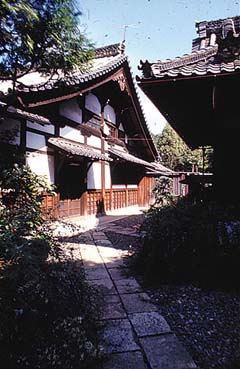
Kyōto Myōan-ji, Main Hall completed in 1969
Photo by Torsten Olafsson, early Spring, 1977
1972: Koizumi Ryōan retires and is followed by Fukumoto Kyoan as 39th 'Kansu'.
Source: http://myouan-doushukai.org/generation.html
1972: Okamoto Chikugai, 岡本竹外,
authors a short essay on 'Suizen' breathing - eventually published in 2012 by the Myōan Sōryū-kai.
Sources: http://myoanshakuhachi.blogspot.com/2015/08/collection-of-suizenblowing-zen.html
http://myoanshakuhachi.blogspot.com/2015/08/collection-of-suizenblowing-zen.html?m=1&fbclid=IwZXh0bgNhZW0CMTEAAR1sp1hP1ila06CGIyRcbTzQPpH3Mfz9RSQPy5RbC_kTYm4ZfNtsY66jU-E_aem_nu9qBZHqKvCaYtORno4zow
You can purchase that printed 2012 edition here:
https://hj-how.com/SHOP/list.php?Search=5453&FROM_ENCODING=U
1974: The record company Nippon Columbia releases a triple-LP record set titled 'Suizen', featuring Sakai Chikuhō II
- who really was not a 'Taizan-ha Suizen' player, at all.
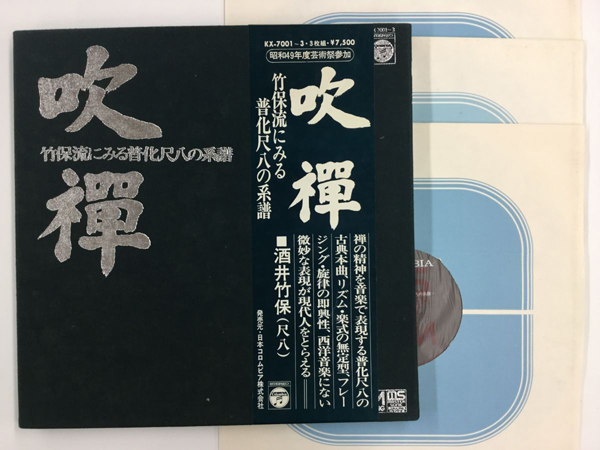
1974: Kamisangō Yūkō writes about 'Komusō' and 'Suizen' in the booklet for Nippon Columbia's triple-LP set 'Suizen':

普化宗の確立の結果、
乞食坊主や風狂
または無宿の徒まで
含んでいた薦僧集団が、
浪人(武士階級)に資格を限り、
吹禅と武者修行を業とする
宗教団体に,
いわば昇格したのであるから ...
"As an outcome of the establishment of the Fuke Sect
the 'komosō' groups that included beggar monks and lunatics,
be they homeless persons,
(turned into) a religious group of 'rōnin' "wave men",
the membership privilege of whom was limited to persons with samurai rank
who performed 'suizen'
and samurai martial arts,
(thus) climbing in status, so to speak ..."
Source: Kamisangō Yūkō, 'Suizen' LP booklet, 1974, p. 17.
Trsl. by Torsten Olafsson, 2020.
Read more here:
1974: 'Komusō' & 'Suizen'?: The Emperor's New Clothes!
PART 1
What Prof. Kamisangō Yūkō Once Precisely Told Us
about Supposed "Edo Period 'Komusō Suizen' Life"
1974: 'Komusō' & 'Suizen'?: The Emperor's New Clothes!
PART 2
What Prof. Kamisangō Yūkō Once Precisely Told Us
about Supposed "Edo Period 'Komusō Suizen' Life"
1974: The Year of the End of 'Shakuhachi Suizen'
- When the Term 'Suizen' was Kidnapped, Hi-jacked,
and Degraded into Mere "New Age", "Healing",
"Holism", and "Mindfulness" Meaninglessness
By the way: No, 'Suizen' is not mentioned even once in any of the numerous Edo Period texts about shakuhachi-playing 'Rōnin' and 'Komusō'!
1975: 'Suizen' is not mentioned in any of the articles in the Kikan Hōgaku 5 special 'shakuhachi' edition of 1975!
Name of authors: Kikkawa Eishi & Nishiyama Matsunosuke.
1976: After the sudden death of Fukumoto Kyoan, Yoshimura Sōshin is appointed 40th 'Kansu'.
Source: http://myouan-doushukai.org/generation.html
無穴笛 吹禅 - MU-KU-TEKI SUIZEN
1970s? - no later than Spring, 1978:
Myōan-ji's 2nd chief monk, Hirazumi Taizan, creates a unique 'Mu-ku-teki Suizen',
無穴笛 吹禅,
"No-holes-flute sui-zen' calligraphy hanging scroll - read more below, at page bottom.

1977, August 9:
LETTER from YOSHIMURA 'FUAN' SŌSHIN to TORSTEN OLAFSSON
禅尺八 - 'ZEN SHAKUHACHI'
修養の尺八 - 'SHŪYŌ no SHAKUHACHI'
"The Shakuhachi of Self-cultivation and Self-discipline"
The Myōan Taizan-ha Way of Authentic Shakuhachi 'Suizen' Asceticism
represented by Yoshimura 'Fuan' Sōshin, 40th 'Kansu' of Kyōto Myōan-ji:
明暗寺四十世 芳村普庵宗心
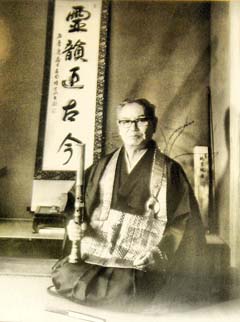
Yoshimura 'Fuan' Sōshin - 1904-1998
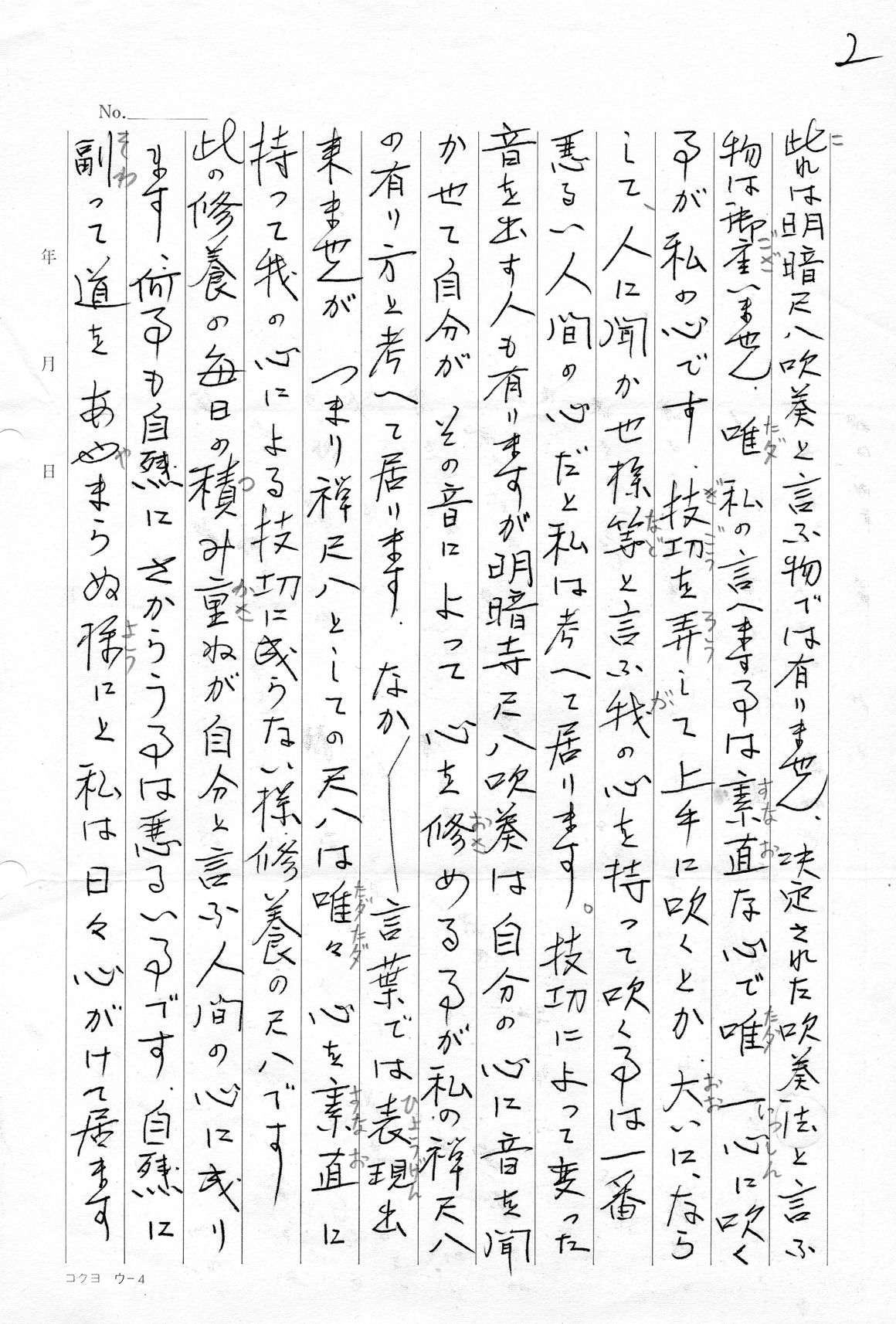
Yoshimura 'Fuan' Sōshin's letter to Torsten Olafsson, August 9, 1977, page 2
- - - なかなか言葉では表現出来ませんが、
つまり禅尺八としての尺八は唯々
心を素直に持って, 我の心による
技功に成らない様、修養の尺八です。 - - -
" - - - I can not easily express this in words, but to practice the shakuhachi of 'Zen Shakuhachi' is indeed a way of mental training and self-cultivation that is practiced
with an open and humble mind and does not develop into technical skill with a selfish attitude. - - - "
Read the full translation on this webpage - opens in a new browser window:
The Legacy of the Late Myōan Taizan-ha Teachers
Yoshimura 'Fuan' Sōshin & Ozawa Seizan
1978, Spring: Ozawa Seizan, a close student of Yoshimura 'Fuan' Sōshin's, describes the meaning and "purpose" of 'Suizen'
in a letter of recommendation to his shakuhachi student, Torsten Olafsson, Denmark:
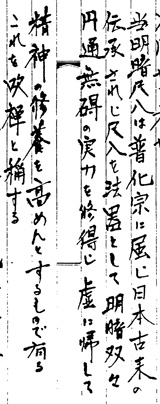
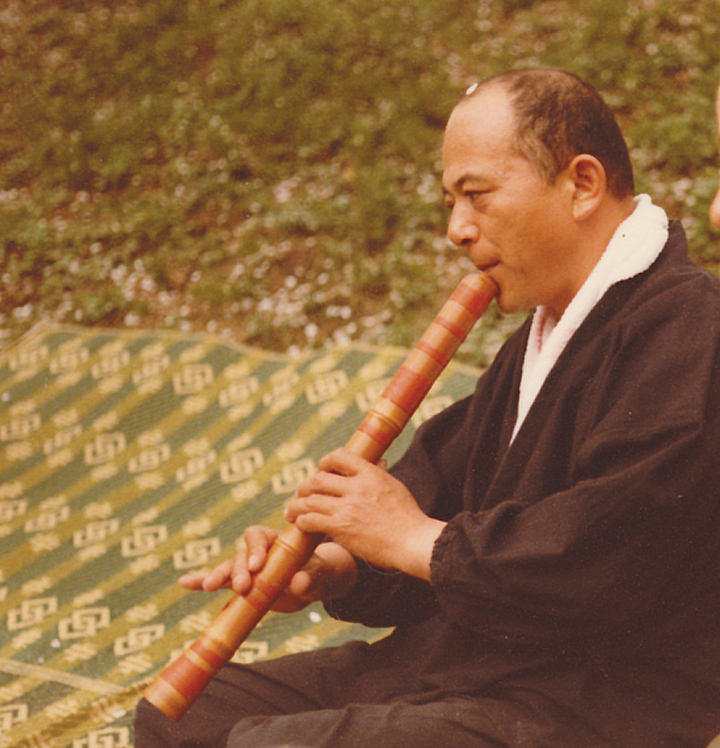
Detail of a letter of recommendation for Torsten Olafsson
written by Ozawa Seizan in Spring, 1978
Photo to the right by T.O.
当明暗尺八は、普化宗に属じ日本古耒の伝承されじ
尺八お法器として、明暗双々円通無碍の実力を修得じ、
虚に帰して、精神の修養を高めんとするしので有る。
これを吹禅と稱する。
"Myōan Shakuhachi is related to the Fuke Sect of Shakuhachi and it has as its purpose to employ the ancient Japanese shakuhachi flute as a Dharma instrument [hō-ki]
in order that one understands the Ultimately Adual Nature of the 'Bright' and the 'Dark' [Myō-An] and experiences the Essence of Non-Substantiality
[kyo] through Self-Cultivation.
This practice is called 'Suizen'."
By Ozawa Zetsugai Seizan, 1939-2012, Myōan-ji, 1978, in a letter
of recommendation to the author. Trsl. by Torsten Olafsson.
吹禅一如
1978? - probably so: The 40th Myōan-ji 'Kansu', Yoshimura 'Fuan' Sōshin,
and Myōan-ji, release a 4-LP record set titled 'Suizen ichi-nyo',
吹禅一如,
"The Oneness of Meditating while Blowing a Flute" - or rather, "Blowing a Flute and Meditating are Not Separate".
Or, I'd rather recommend a translation like this, for instance: "The Non-Duality of Meditating while Blowing a Flute".
Yasuda Tenzan is the actual "artist" who wrote that very 'Suizen ichi-nyo' calligraphy for the LP front covers:
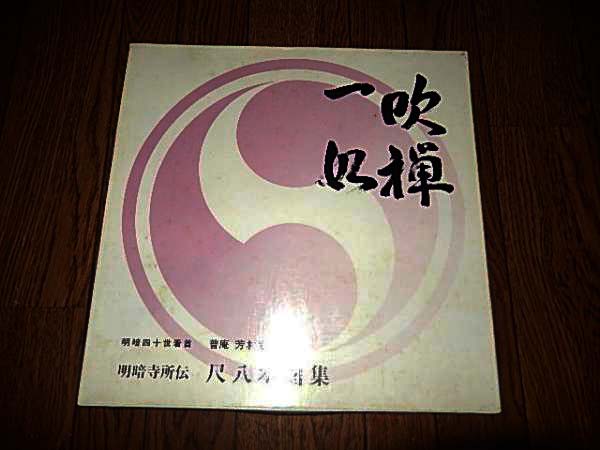
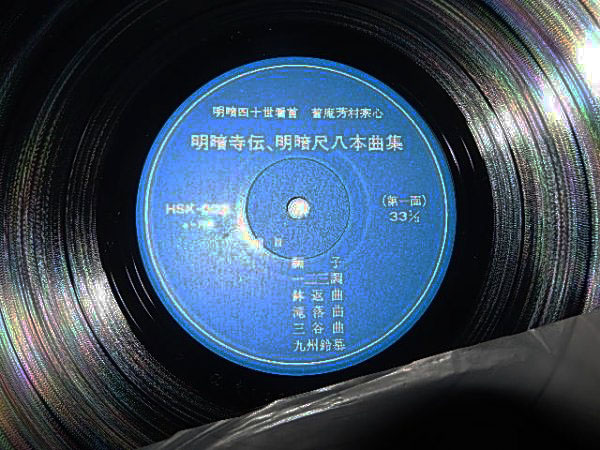
Phonogram numbers: HSK-003~006 - towa33.com, 2nd hand product description, screen dumps:
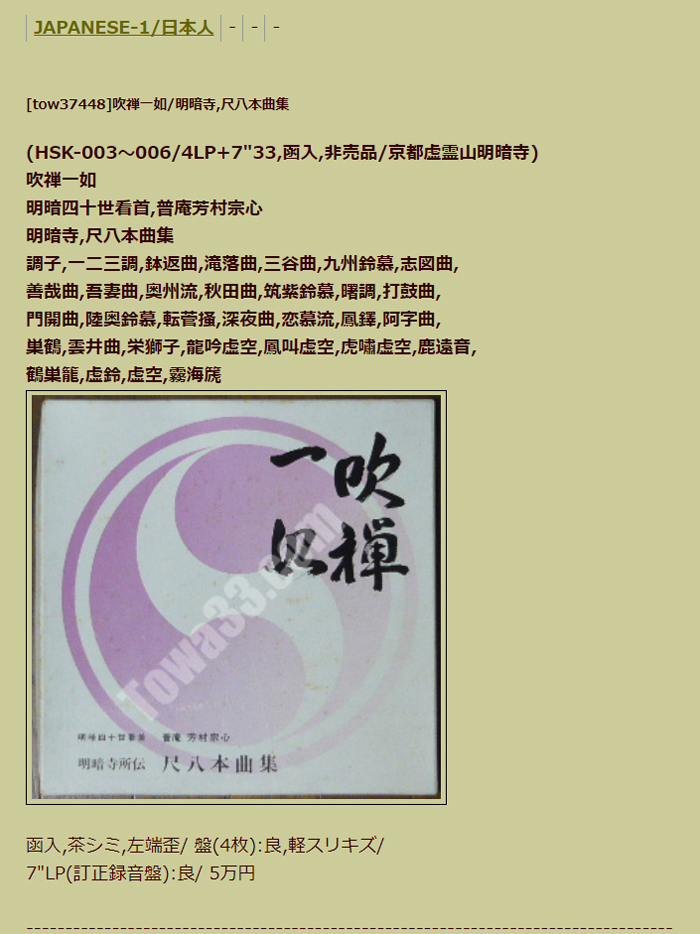
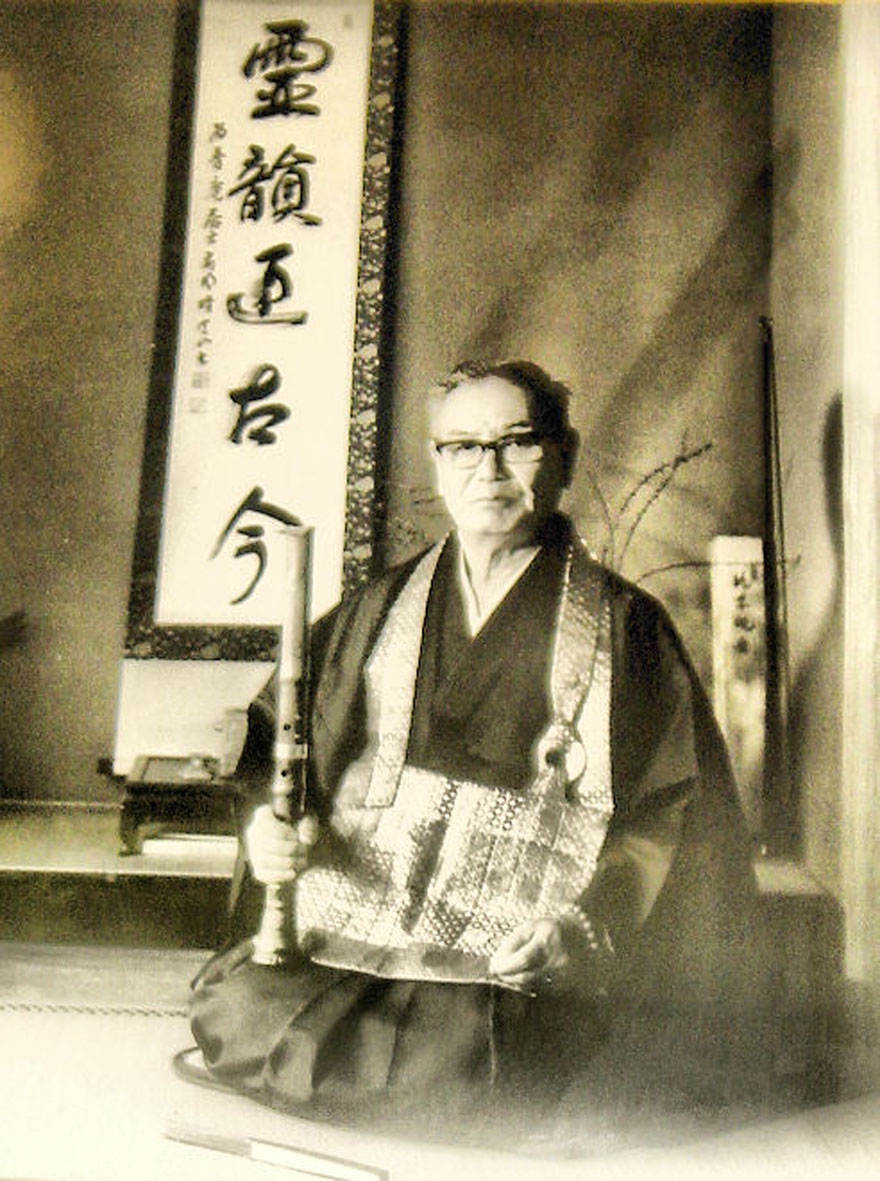
Nihon no Furuhon-ya, 2nd hand product description, screen dump:
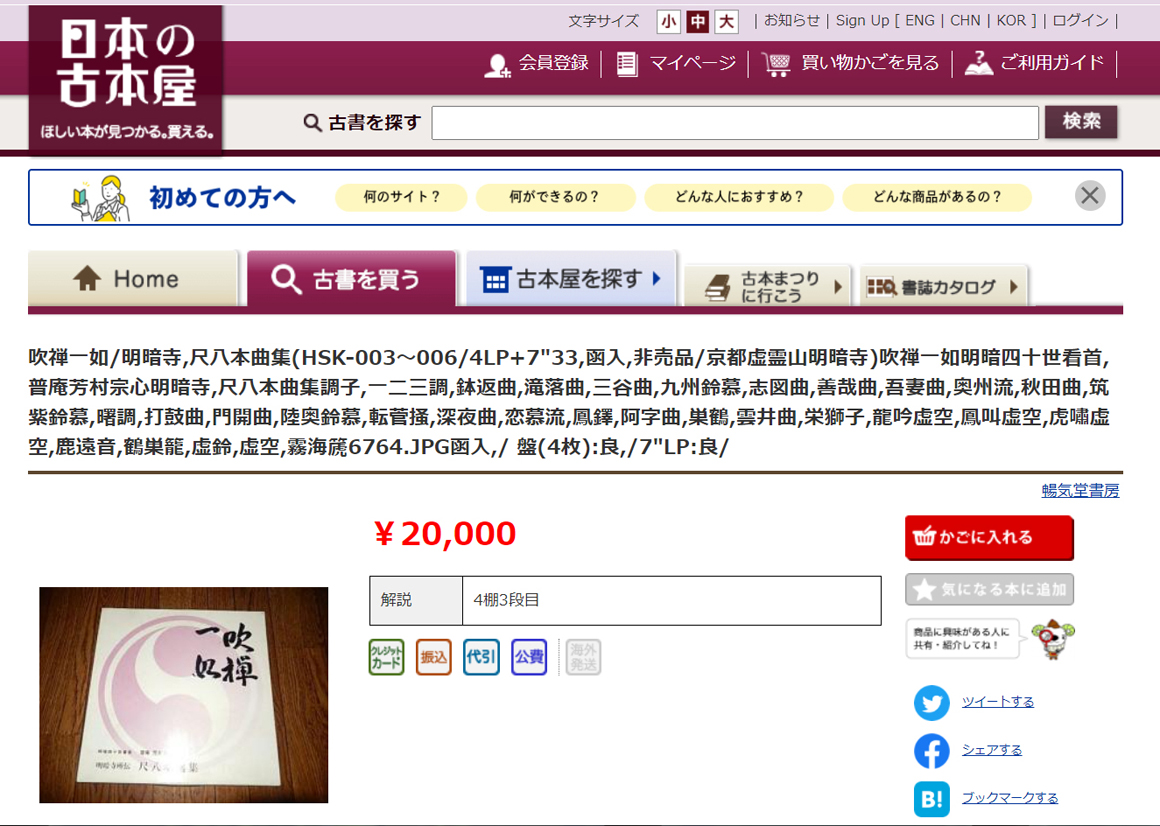
Sources: http://towa33.com/?page=70&cid=14
https://www.kosho.or.jp/products/detail.php?product_id=336933021
Complete Furuhon-ya description in Japanese:
吹禅一如
吹禅一如/明暗寺,
尺八本曲集
(HSK-003~006/4LP+7"33,函入,非売品/
京都虚霊山明暗寺)
吹禅一如
明暗四十世看首,
普庵芳村宗心明暗寺,
尺八本曲集
調子,
一二三調,
鉢返曲,
滝落曲,
三谷曲,
九州鈴慕,
志図曲,
善哉曲,
吾妻曲,
奥州流,
秋田曲,
筑紫鈴慕,
曙調,
打鼓曲,
門開曲,
陸奥鈴慕,
転菅掻,
深夜曲,
恋慕流,
鳳鐸,
阿字曲,
巣鶴,
雲井曲,
栄獅子,
龍吟虚空,
鳳叫虚空,
虎嘯虚空,
鹿遠音,
鶴巣籠,
虚鈴,
虚空,
霧海篪
1983: Okamoto Chikugai: "'Ōshū reibo' ni tsuite: Ōshū no suizenhō."
In: Ichion jōbutsu, Issue No. 5, June 1, 1983, pp. 2-22.
1983: Torsten Olafsson & Olafssongs, Denmark, produce the LP/MC
"Standing Waves. Zen Shakuhachi Meditations",
featuring six Myōan Taizan-ha 'Suizen' honkyoku.
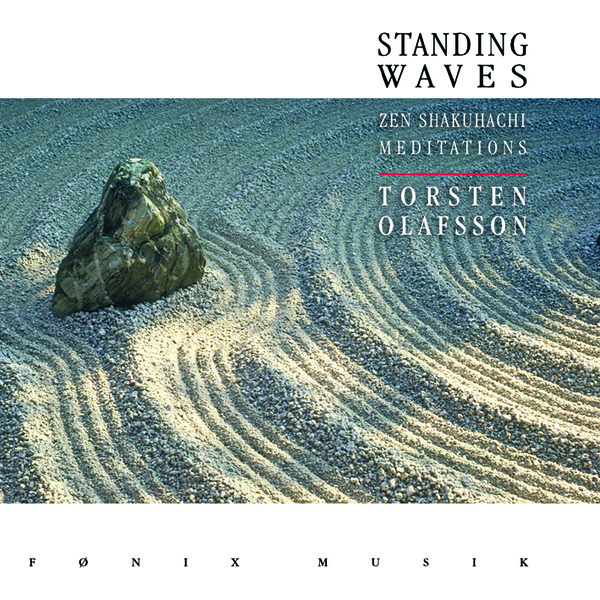
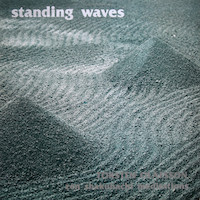
Left: Fønix Music CD reissue, 2001 - Right: Olafssongs LP/MC, 1983.
Btw.: Discogs.com quite misleadingly categorizes LP record as "New Age":
https://www.discogs.com/Torsten-Olafsson-Standing-Waves/release/2199217
https://www.discogs.com/Torsten-Olafsson-Standing-Waves-Zen-Shakuhachi-Meditations/release/9387521
吹禅 悟道 - SUIZEN GODŌ
1985: Matsumoto Kyozan includes a 'Suizen godō',
吹禅 悟道,
calligraphy on the front page of a 'honkyoku gakufu' collection of his.
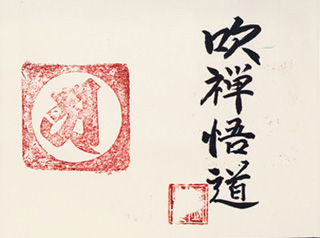
Read more at page bottom.
1985?: Nippon Columbia releases a
'Komusō Chiku-in Suizen' 'Fuke-shū Tani-ha Kyotaku' vinyl LP
虚無僧 竹韻 吹禅 普化宗 谷派 虚鐸
Go to 1998, June 20, to read more about a reissue on CD in that year.
1991: Yoshimura Sōshin retires and is succeeded by Kojima Hōan as 41st 'Kansu'.
Source: http://myouan-doushukai.org/generation.html
1994: Tukitani Tuneko, Seyama Tōru & Simura Satosi write about 'Suizen' in an article presented in English, trsl. by Riley Kelly Lee:
"It was not so easy to become a member of the Fuke sect or a komusō.
This was due to the arrangement of the system of rules as determined by the Tokugawa shogunate.
Accordingly, it can be said that the shakuhachi has been handed down to us within a limited, chartered organisation.
That organization maintained an ideology centered around Zen Buddhism.
Moreover, Zen in the Fuke sect was nothing but the playing of the shakuhachi.
This ideology and lifestyle was called suizen ('blowing Zen').
Thus, in terms of suizen, the shakuhachi was not a musical instrument, and naturally pieces performed on it were not considered as being music.
To them, the shakuhachi was a hōki ('religious instrument'), that is to say, a sacred tool for the purpose of spiritual training.
If one were to use the above-mentioned emic viewpoint, within the organisation of the komusō the shakuhachi was not included in 'music', or rather was not allowed to be included."
Source: Tukitani Tuneko, Seyama Tōru, Simura Satosi and Riley Kelly Lee, translator (1994):
'The Shakuhachi: The instrument and its music, change and diversification."
In: Contemporary Music Review, 8:2, p. 111
Download link: https://www.tandfonline.com/doi/abs/10.1080/07494469400640091
Comment: No, 'Suizen' was definitely neither an "ideology" nor a "lifestyle" of the members of the so called "Fuke Sect" during the Edo Period.
The term does not appear anywhere before 1950, at the very earliest, in any Japanese literary source related to shakuhachi history,
ideology or practice in any way, at all. Period.
吹禅 一如 - SUIZEN ICHI-NYO
1995: A Yoshimura 'Fuan' Sōshin's 'Suizen ichi-nyo' triple-CD set is issued by Myōan-ji -
quite certainly the same recordings as those that were previously published on 4 vinyl LP records, sometime in the 1970s?
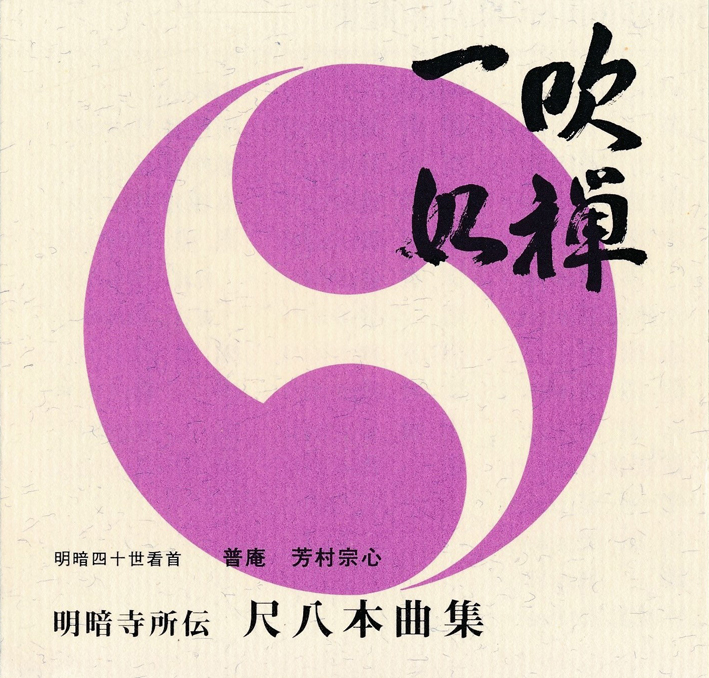

Phonogram numbers: KM-1995 01-03.
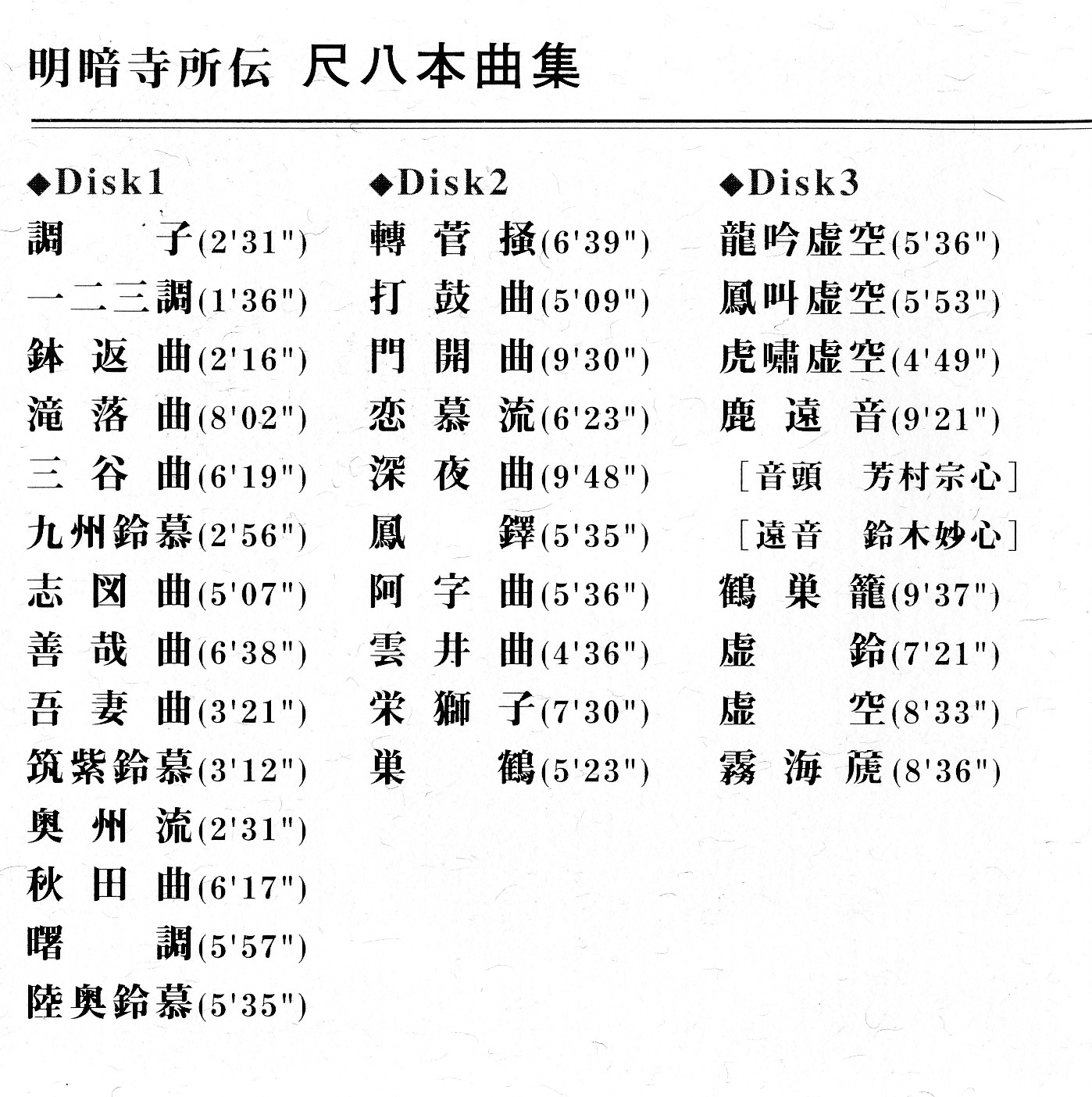
Yoshimura 'Fuan' Sōshin 'Suizen ichi-nyo' CDs track list
Despite the fact that Yoshimura 'Fuan' Sōshin's Taizan-ha 'Suizen' shakuhachi recordings of the 1970s are verily titled
'Suizen ichi-nyo' on the front cover and elsewhere,
吹禅一如,
"Blowing the Shakuhachi & Self-cultivation Are Not Two" [literally: "Are One"],
at the ISS/International Shakuhachi Society website komuso.com, Yoshimura Sōshin's recordings are registered under the misleading headline
'Meianji Shoden Shakuhachi Honkyoku Shū' 1-3,
明暗寺所伝尺八本曲集:
"Anthology of Myōan Temple Shakuhachi Tradition Honkyoku"
Links to track lists at Komuso.com with short sound samples:
https://www.komuso.com/albums/albums.pl?album=60
https://www.komuso.com/albums/albums.pl?album=326
https://www.komuso.com/albums/albums.pl?album=529
1997, November 30 (re-issued in 2016, see below):
Seian Genshin, editor, and the 'Myōan Shakuhachi Bō-chiku-kai',
明暗尺八忘竹会, the "Myōan Shakuhachi Memorial Society",
publish the first edition of a monumental memorial tribute book about the legendary 40th Myōan-ji 'Kansu',
Yoshimura 'Fuan' Sōshin, 1904-1998.
Go to the year 2016 below to read more, see the front cover, and how to order from Japan.
Link regarding Seian Genshin 'Kansu', WSF 2018: http://wsf2018.com/ja/people/%E9%85%92%E4%BA%95%E7%8E%84%E5%BF%83
1998, June 20: Nippon Columbia reissues a
'Komusō Chiku-in Suizen' 'Fuke-shū Tani-ha Kyotaku' LP on CD
Columbia – COCF-15174. First released on LP in 1985?
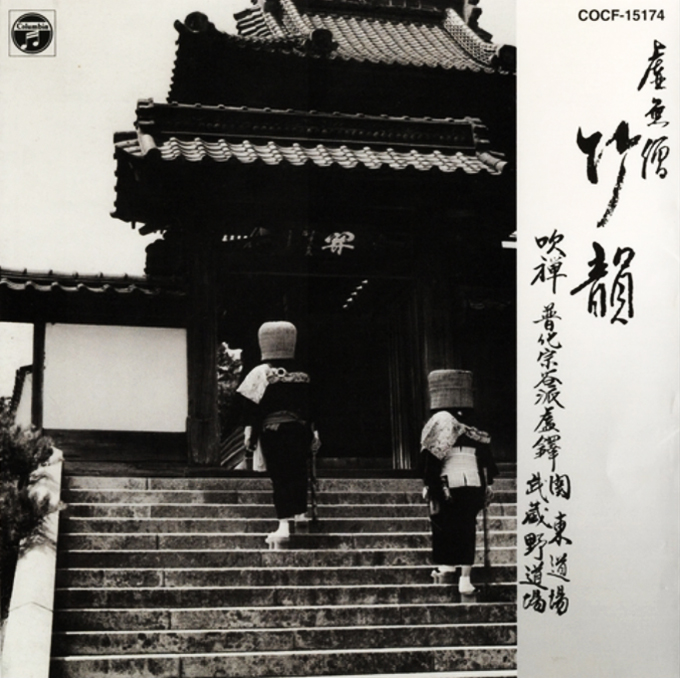
虚無僧 竹韻 吹禅 普化宗 谷派 虚鐸
First found at this website: https://www.hmv.co.jp/en/artist_Various_000000000000075/item_%E8%99%9A%E7%84%A1%E5%83%A7-%E7%AB%B9%E9%9F%BB_319112
See also: https://www.discogs.com/%E6%99%AE%E5%8C%96%E5%AE%97%E8%B0%B7%E6%B4%BE%E8%99%9A%E9%90%B8-%E9%96%A2%E6%9D%B1%E9%81%93%E5%A0%B4-%E6%AD%A6%E8%94%B5%E9%87%8E%E9%81%93%E5%A0%B4-%E8%99%9A%E7%84%A1%E5%83%A7-%E7%AB%B9%E9%9F%BB/release/12415418
2000: Tsukitani Tsuneko writes but just a little about 'Suizen' in her monumental book
'Shakuhachi koten honkyoku no kenkyū'.
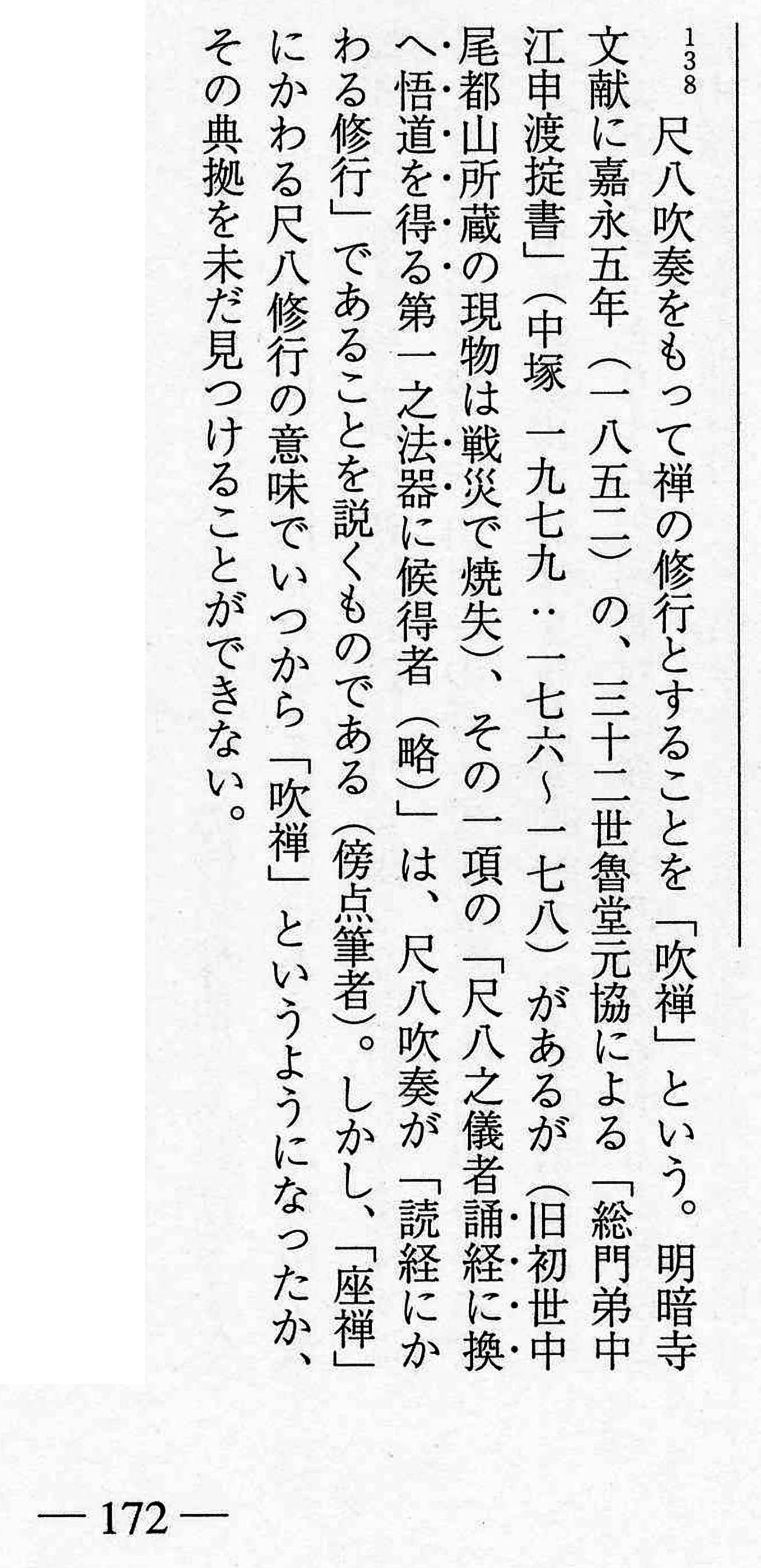
The late professor Tsukitani Tsuneko's comments about 'sui-teki shugyō'
and the possible origin of the term 'suizen'. Tsukitani 2000, p. 172, note 138.
In her monumental study of 'koten honkyoku', published in 2000, Prof. Tsukitani hardly at all touched upon the topic of 'Suizen'.
In note 138 on page 172, the first sentence states that,
"Playing the shakuhachi as an ascetic meditative discipline [Zen no shugyū, ed.] is called 'Suizen'."
The last sentence then reads,
しかし、「座禅」にかわる尺八修行の意味でいつから
「吹禅」というようになったか、
その典拠を未だ見つけることができない。
namely, "However, I can not yet find any written reference to when 'Suizen' became a term for 'Zazen' seated meditation
that changed into 'ascetic shakuhachi discipline' ['Suizen', ed.]."
Translated by Torsten Olafsson.
Source: Tsukitaki Tsuneko, 2000, page 172, note 138.
2001: Okada Fujio publishes a book titled 'Komusō no nazo - Suizen no kokoro.'
虚無僧の謎. 吹禅の心
"The Komusō Mystery - The Essence of Suizen."
Akita Bunka Shuppan, 2001.
2001, November 24: Nippon Columbia releases a CD named 'Nihon no gakki: Shakuhachi'
"Japanese Music Instruments: Shakuhachi." Track 1 on the record has the title
'Suizen Kokū Shakuhachi Fukeshuu Tani-ha Kyotaku',
吹禅 虚空
Shakuhachi –
普化宗谷派 虚鐸
Source: https://www.discogs.com/Various-%E6%97%A5%E6%9C%AC%E3%81%AE%E6%A5%BD%E5%99%A8-%E5%B0%BA%E5%85%AB-Japanese-Music-Instruments-Shakuhachi/release/11230892
2004: The first Western shakuhachi record release titled 'Suizen'?
Ronnie Seldin and Barbara Lee Kroos publish the 5-CD & book set
"Sui Zen. Blowing Zen On the Shakuhachi":
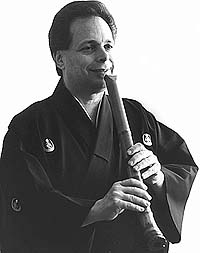
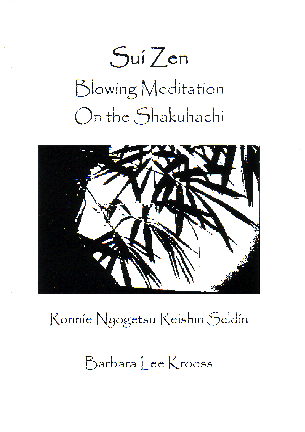
2005: Takahata Sōyū publishes a book about 'Suizen' titled
'Yasei no zen. Suizen'.
2005: Takahata Sōyū publishes a book about 'Suizen' titled
"Myōan Shakuhachi. Suizen: The Zen of Wildness.'
2005: Steve Weiss designs a map of "26 Suizen Temples", allegedly "approved" by Kurahashi Yoshio:
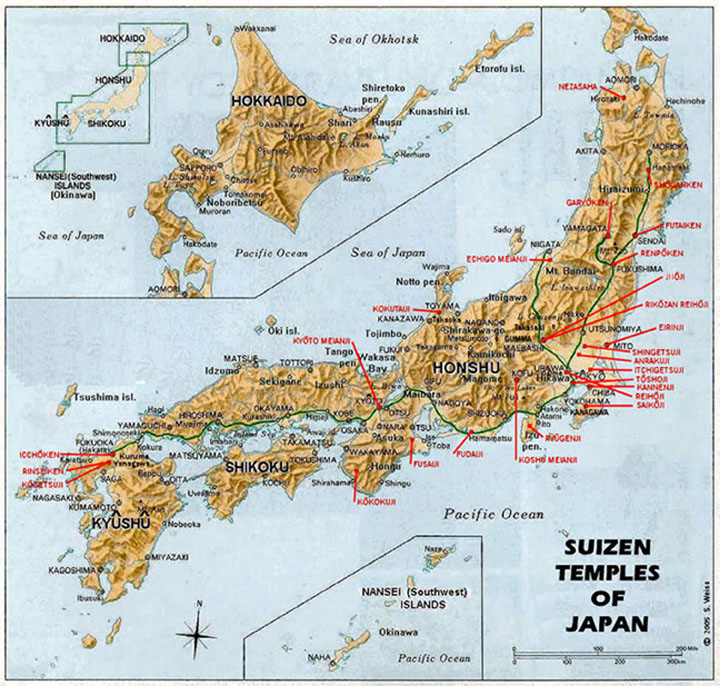
Map of 26 "'Suizen' temples" - during the late Tokugawa Period ... really?
Compiled by Steve Weiss, 2005, approved by Kurahashi Yoshio.
There were, of course, no such "'Suizen' temples" mentioned anywhere, nor ever,
in Edo Period documents! Source of map: www.shakuhachi.com
2008: Tsukitani Tsuneko states regarding 'Suizen' in her article in "The Ashgate Companion to Japanese Music":
"The Fuke sect was named after its putative Tang Chinese founder, Pu-hua (Jap. Fuke).
It has no doctrines or scriptures, parishioners or lay believers;
its equivalent to Zen meditation or sutra recitation is the playing of shakuhachi
- what practitioners call suizen (blowing Zen).
No such use is recorded in China."
Source: Tsukitani Tsuneko in "The Ashgate Companion to Japanese Music," 2008, p. 150.
2009, August 8: US citizen and longtime Myōan Taizan-ha shakuhachi player Dean Seicho Delbene posts this illustration on his "Myoan Shakuhachi Blogspot" Website:

Tomimori Kyozan's statement regarding the origin of the terms suizen/sui-shō-zen, no date.
Possibly a short transcript of the interview that took place on October 27, 1968,
see entry page up.
Do note, though, that neither 'Sui-shō-zen' nor 'Sui-zen' can be found any Chinese text, whatsoever.
Link: http://myoanshakuhachi.blogspot.com/2009/08/suizen-origin-suishouzen.html?m=0
2009, October: Kyōto Myōan-ji 'Kansu' Kojima Hōan informs Christian T. Mau
that it was Yasuda Tenzan who "coined", invented, the new term 'Suizen' while he served as the first chief monk of that newly revived temple in the period 1950-1953.
Source: Christian T. Mau Ph.D. thesis, 2014, p. 116.
Link: http://eprints.soas.ac.uk/18260
2010: Tago Kōin publishes an article titled 'Suizen no yurai ni tsuite', "About the origin of Suizen," in the magazine Tozan-ryū Gakuhō
Source: http://www.tozanryu.com/about/reference/download/gakuho.pdf
2012:
A group of Taiwanese shakuhachi players visit Kyōto and the Myōan Temple there and many pictures are taken.
The calligraphy over the altar in the temple main hall reads 'Suizen ichi-nyo', kanji reading from the right,
吹禅一如.
The calligrapher's signature is not possible to read in this particular digital picture file.
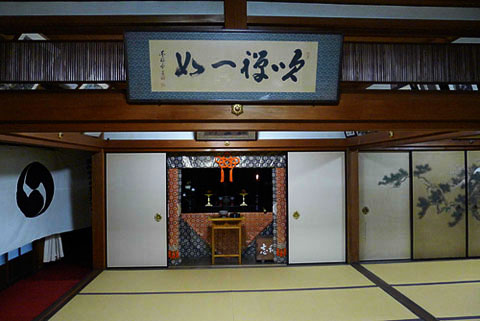
Original, first link to the online source, has however now disappeared, as of late 2023:
https://blog.xuite.net/shakuhachi.taiwan/twblog/157539267
Link to Taiwan Shakuhachi website, English language page:
http://www.chibaxiao.com/post/TaiwanShakuhachi.html
2015, February 25: Nippon Columbia releases a double CD named 'Nihon no gakki - Koto / Shakuhachi
"Japanese Music Instruments: Koto / Shakuhachi." Track 1 on CD 2 has the title
'Suizen Kokū Shakuhachi Fukeshuu Tani-ha Kyotaku',
吹禅 虚空
Shakuhachi –
普化宗谷派 虚鐸
Source: https://www.discogs.com/Various-%E6%97%A5%E6%9C%AC%E3%81%AE%E6%A5%BD%E5%99%A8-%E7%AE%8F%E5%B0%BA%E5%85%AB-Japanese-Music-Instruments-Koto-Shakuhachi/release/11221155
2015:
Seian Genshin, editor, and the 'Myōan Shakuhachi Bō-chiku-kai',
明暗尺八忘竹会, the "Myōan Shakuhachi Memorial Society",
publish a set of 4 DVDs featuring - thus paying proper respect to - the legendary 40th Myōan-ji 'Kansu',
Yoshimura 'Fuan' Sōshin, 1904-1998:
吹禅~吹け吹くな~鳴らせ鳴らすな~
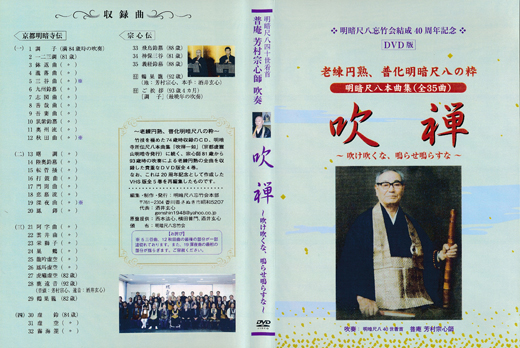
'Suizen - fuke fuku na - narase narasu na - '
"Suizen - Blow, Don't blow - Ring, Don't ring - "
You may order internationally from HoW/Hogaku on the World CD Shop:
https://hj-how.com/SHOP/4138.html
Link regarding Seian Genshin 'Kansu', WSF 2018: http://wsf2018.com/ja/people/%E9%85%92%E4%BA%95%E7%8E%84%E5%BF%83
2016, October 21 (first issued in 1997, see above):
Seian Genshin, editor, and the 'Myōan Shakuhachi Bō-chiku-kai',
明暗尺八忘竹会, the "Myōan Shakuhachi Memorial Society",
publish a second edition of a monumental memorial tribute book, now including 3 music CDs, about the legendary 40th Myōan-ji 'Kansu',
Yoshimura 'Fuan' Sōshin, 1904-1998:
忘竹~明暗尺八の心
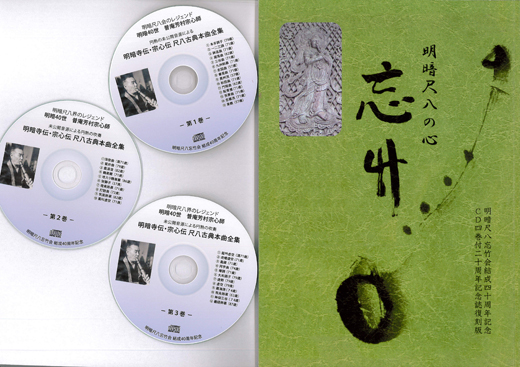
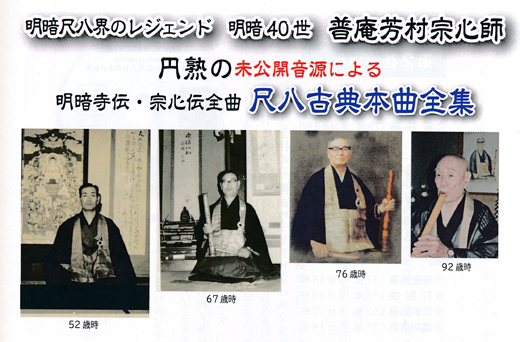
"Legend of the World of Myōan Shakuhachi, the 40th 'Kansu', Mr. 'Fuan' Yoshimura Sōshin
Based on hitherto unpublished fine recordings
Myōan-ji Tradition - Complete Sōshin Tradition Complete Collection
Complete Classical Shakuhachi Honkyoku Anthology"
You may order internationally from HoW/Hogaku on the World CD Shop:
https://hj-how.com/SHOP/1581.html
Link regarding Seian Genshin 'Kansu', WSF 2018: http://wsf2018.com/ja/people/%E9%85%92%E4%BA%95%E7%8E%84%E5%BF%83
2017: Kojima Hōan retires and Seian Genshin becomes the 42nd 'Kansu'.
Source: http://myouan-doushukai.org/generation.html
日々の吹禅 - HIBI no SUIZEN
2019: Seian Genshin & Kyōto Myōan Kyōkai produce the CD
'Hibi no Suizen', "Daily Suizen"/"Everyday Shakuhachi Asceticism":
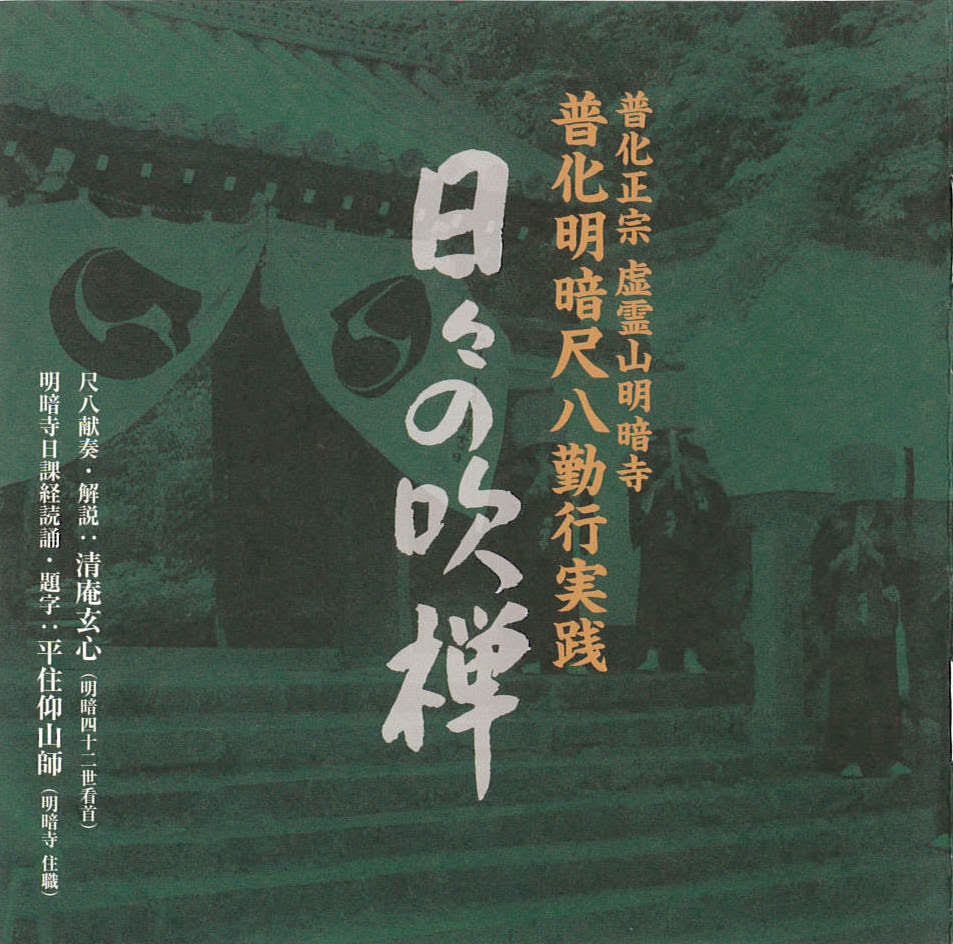
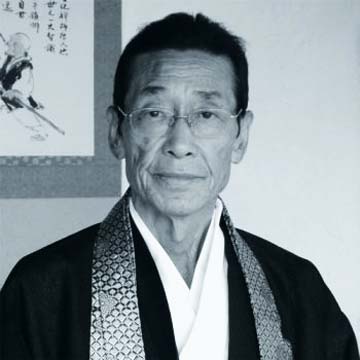
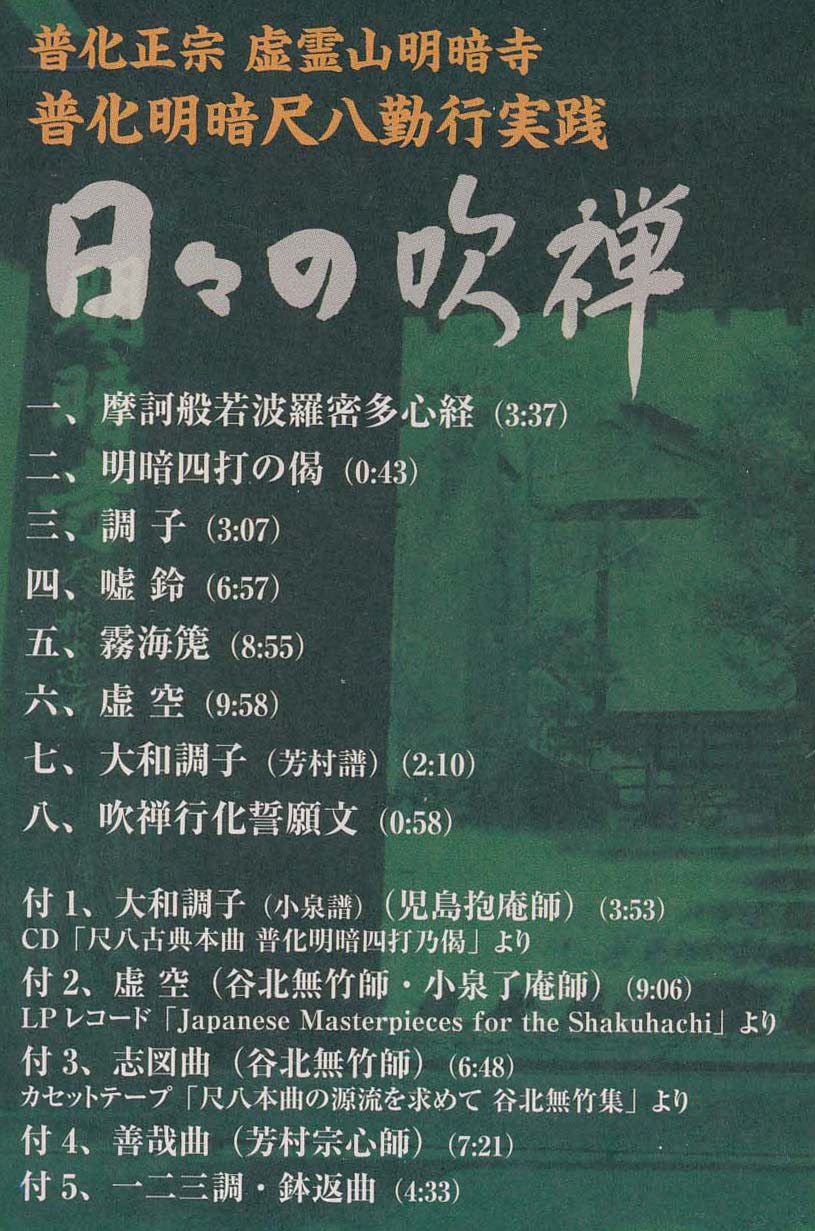
Seian Genshin, 42nd 'Kansu' - 'Hibi no Suizen' CD track list
You can purchase that really important CD here
at HoW/Hogaku of the World CD Shop:
https://hj-how.com/SHOP/1618.html
Besides, former ESS Chair Person Kiku Day can also deliver to you - just inquire with her at kikuday[at]gmail.com.
CD ALBUM REVIEW:
In the digital, online available European Shakuhachi Society Newsletter 2019, Vol. 2, on pages 30-32,
you can find and read a lengthy, very respectful, review written by former ESS Chair Person, Kiku Day - here quoted in however only short,
"The CD Hibi no Suizen is wonderful."
Link to ESS Newsletter 2019 Vol. 2:
http://files.shakuhachisociety.eu/publications/newsletters/ESS%20NEWSLETTER%202019%20vol2.pdf?fbclid=IwAR2FEomslvNmSS-KmfRbd0_9Bqfhh9PfQUTyqQ9OE-mE-FfWQk90aIzz30w
2019, May 9: A Fine 'Suizen ichi-nyo' calligraphy scroll is displayed
in Kurahashi Yōdō's 'tokonoma' alcove- screen dump from video
"ShakuCamp 2019 - video #4 - Kurahashi Yōdō
Kurahashi-sensei talks about the Shakuhachi Summer Camp of the Rockies"
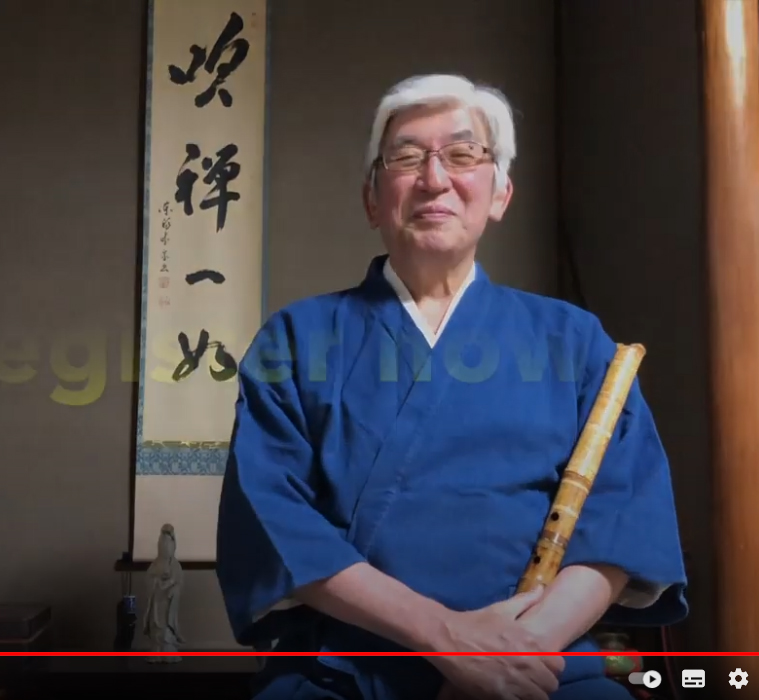
Link to Youtube, Elliot Kallens's Channel:
https://www.youtube.com/watch?v=EFeMEnPKgmc&ab_channel=ElliotKallen
2024: Still, as of July 5: The Myōan Dōshu-kai representatives themselves declare on the Myōan temple's website - among other contradictory statements -
that it was the renowned Shingon Buddhist, later to become a Zen monk, Shinchi Kakushin/Hottō Kokushi, 1207-1298,
who
"instituted 'Sui-shō-zen' and 'Sui-zen', ['kakuritsu saremashita',
確立されました],
as the alternative, though also somehow equivalent, practice of Buddha realization through 'Za-zen',
座禅"
- in the middle of the 13th century, that should have taken place ... well, I mean: really?
Quotation from the web page in question, in Japanese:
「法燈国師は尺八をもって座禅一助の便法、
禅定悟得の妙法とした指導理念で
「吹簫禅すいしょうぜん」すなわち
「吹禅すいぜん」を確立されました。」
Romanization:
'Hottō Kokushi wa shakuhachi o motte
zazen ichijo no benpō, zenjō gotoku no myōhō
toshita shidō rinen de
「suishōzen」 sunawachi 「suizen」 o kakuritsu saremashita.'
Source: http://myouan-doushukai.org/suizen.html
The official Kyōto Myōan Temple English translation/adaptation reads as this, though:
"Hotto established suizen of "Blowing Zen meditation" after realizing that blowing shakuhachi is an excellent means of meditation."
Link: http://myouan-doushukai.org/en.html
2021, May 1:
One yet undocumented/undated 'Suizen' record release by Bobby Seigetsu Avstreih:
"Sui-zen Shakuhachi - Vol. 1-2"
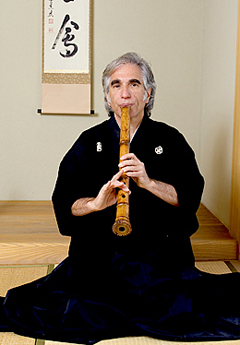
"Devoted to the Meian sui-zen repertoire in the Jin Nyodo tradition.
Primary teachers Ronnie Nyogetsu Seldin and Kurahashi Yoshio.
Received name Seigetsu at Ki Sui An Dojo 1987."
Source: www.komuso.com.
Links: https://www.komuso.com/people/people.pl?person=1784
https://www.komuso.com/albums/index.pl?title_letter=S
|

吹
簫
禅
吹
禅
尺
八
修
養
尺
八
修
行
行
の
音
楽
吹
禅
悟
道
吹
竹
禅
|
